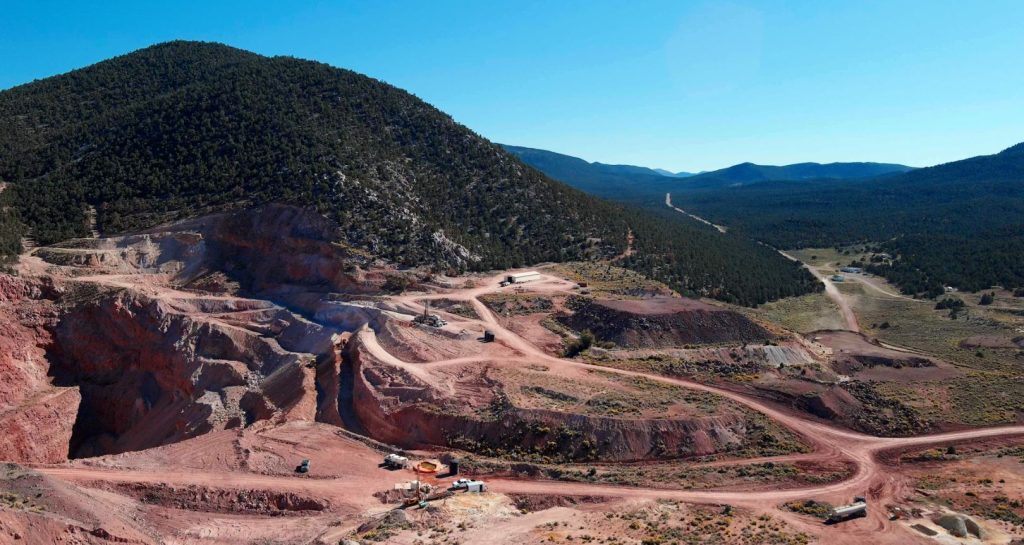Nevada King drills 1.9 g/t gold over 78 metres at Atlanta gold mine, Nevada

Nevada King Gold Corp. [NKG-TSXV; NKGFF-OTCQX] reported assay results from four reverse circulation (RC) holes recently completed at its 100%-owned Atlanta Gold Mine Project located 264km northeast of Las Vegas, Nevada, in the prolific Battle Mountain Trend.
The drilling was designed to test the high-grade feeder zone associated with the Atlanta Mine Fault Zone (AMFZ) west of the historical Atlanta Pit. The feeder zone is located within the mineralized footprint of the Gustavson resource zone; however, this area was sparsley tested by historical drilling that failed to penetrate deep enough.
Gold grade and mineralized thicknesses returned in today’s holes are considerably higher than those found in nearby historical holes. Two holes, AT22HG-16 and AT22HG-17, are more than double the thickness compared to three nearby historical RC holes and are higher grade. Two other holes greatly exceed the nearby historical holes in both grade and thicknesses, with AT22HG-19 showing a 50% increase in both grade and thickness compared to Gold Field’s AC-4.
Three of today’s holes bottomed in mineralization, with the highest grades found at depth. Prior drilling did not penetrate deep enough and mineralization is still open at depth within the western block of the Atlanta West Fault (AWF). AT22HG-16 bottomed in 3 metres of 9.16 g/t Au and 39.2 g/t Ag, AT22HG-17 bottomed in 10.6 metres of 2.69 g/t Au, while AT22HG-19 intercepted 16.8 metres of 4.76 g/t Au and 86.8 g/t Ag near the bottom of the hole.
Today’s holes include significant intervals of silver mineralization. Atlanta historically produced 800,000 ounces of silver and the Gustavson NI 43-101 resource includes an estimated 4.2Moz of Measured and Indicated silver resource and 1.2Moz of Inferred silver resource.
Drill results indicate silver mineralization is concentrated within the AMFZ, with grades exceeding those previously drilled by the Company outside of the AMFZ in 2021 and 2022. As such, silver could end up playing a more significant role at Atlanta moving forward. The Company is working on a compilation of significant silver intercepts from its prior drilling.
Cal Herron, Exploration Manager, stated, “Recent drilling including this new set of deeper holes drilled across the AWF is significantly expanding our target resource envelope. The intrusive ‘plumbing’ intercepted in holes AT22HG-16 and AT22HG-17 west of the AWF could be indicative of a deep crustal rupture coinciding with the ring fracture that bounds the eastern margin of the Indian Peak Caldera. Gold mineralization appears to be centred on a dacitic composition plug, dike or dome that intrudes the volcanic/sedimentary section along the western side of the AWF. We are very pleased with the thicknesses and grades returned in today’s drilling, confirming our view that these had both been significantly underestimated by historic drilling. Importantly as well this mineralization is open to depth with three of the four holes released today bottoming in mineralization, so we currently have no idea how deep the oxide gold mineralization extends at Atlanta. Given the presence of significant intrusive-hosted gold mineralization, deeper holes will undoubtedly shed more light on the Atlanta gold system’s genesis and in the process point us toward new targets to pursue.”
Nevada King is the third largest mineral claim holder in the State of Nevada, behind Nevada Gold Mines (Barrick/Newmont) and Kinross Gold. The company is well funded with cash of approximately $10.2 million as of January 2023.
The Atlanta Mine is a historical gold-silver producer with a NI 43-101 compliant pit-constrained resource of 460,000 oz Au in the measured and indicated category (11.0M tonnes at 1.3 g/t) plus an inferred resource of 142,000 oz Au (5.3M tonnes at 0.83 g/t).
